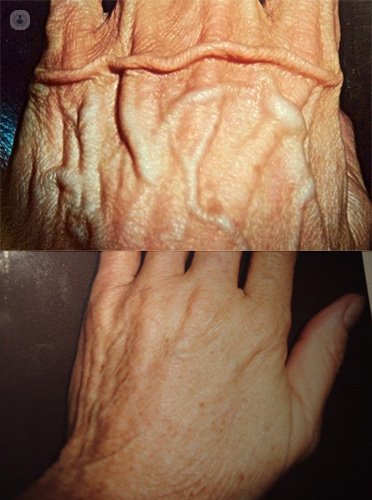Hand vein treatment: is it possible to remove bulging veins in the hand?
Written by:Hands are not easy to ignore, we don’t need a mirror to see them as they cross our eye line several hundred times in a day. However, we are less likely to notice the veins in our hands as much as we do in our legs as they rarely cause any physical discomfort. So, what causes the veins in your hands to pop out? They can become more pronounced over the years particularly in people who have a very low body fat, are thin, have pale complexions, perhaps are exceptionally sporty or have reached the postmenopausal stage. These raised hand or forearm veins may be considered unsightly and although these veins are not strictly varicose veins, it is nevertheless possible to have them removed.

Hand vein treatment:
Hand vein removal is considered a purely aesthetic procedure. Although veins in the hand can be quite painful if knocked, there is no medical reason why anyone should have hand veins attended to. However, the removal of these prominent veins can have a noticeable effect on a patient’s confidence and well-being.
Hand veins are no different to veins on any other area of the body. The permanent removal of them is therefore much the same. The procedure is surprisingly pain free although there is usually some bruising. Results are seen within a couple of weeks and can be quite remarkable. Occasionally new veins can appear but treatment can be repeated if necessary.
How to treat veins on hands:

- Foam sclerotherapy:
Foam sclerotherapy treatment involves injecting foam into the veins of the hands. As the fluid is injected into the vein it forces the blood out, allowing the sclerosant in the foam to effectively kill the vein which will, over the next few weeks, be reabsorbed by the body much as a bruise would be. Patients wear a compression glove for 2 weeks after having foam sclerotherapy to reduce swelling. The full benefit of the treatment may take a few weeks but this treatment involves no hospital stay or anaesthetic.
- Surgical removal:
Surgical removal may be necessary if the veins are large and/or tortuous (twisted), which would not allow the foam sclerotherapy treatment to be fully effective. In these cases the veins can be removed using radio frequency ablation or tiny puncture incisions. The hands would be bandaged for a week post-surgery and once again the bruising may take a few weeks to disappear completely. These procedures usually involve a day in hospital and a general anaesthetic. However, if you are having your leg veins removed it would be possible to have your hands done at the same time.
Is it safe to remove veins in the hand?
The function of the veins in the hand is to carry blood back from the hands. Along with the veins on the top of the hand, there are veins below the surface. Removal of the surface veins is completely safe, as the veins below the surface still function.
You may experience a slight swelling of the fingers following treatment, but this will subside.
If you are interested in removing the veins in your hand, make an appointment with a consultant vascular surgeon.
Private health insurance companies are unlikely to cover any form of therapy to prominent veins in hands, as removal of hand veins is seen as a cosmetic procedure.


